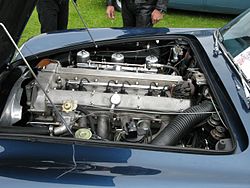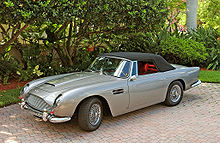- Aston Martin DB5
-
Aston Martin DB5 
Manufacturer Aston Martin Production 1963–1965
1,023 produced[1]Predecessor Aston Martin DB4 Successor Aston Martin DB6 Class Grand tourer Body style 2-door 2+2 coupé
2-door convertible (123)
2-door shooting brake (13)[2]Layout FR layout Engine 3995 cc Tadek Marek I6 Transmission ZF 5-speed all-synchromesh manual or
Borg Warner DG automatic
(changed to Borg-Warner Model 8 shortly before the DB6 replaced the DB5)[3]Length 4.57 metres (179.9 in) Width 1.68 metres (66.1 in) The Aston Martin DB5 is a luxury grand tourer that was made by Aston Martin. Released in 1963, it was an evolution of the final series of DB4. The DB series was named honouring David Brown (the head of Aston Martin from 1947–1972).
The DB5 is famous for being the first and most recognised cinematic James Bond car.[4] It has been featured in several films, most notably Goldfinger, Thunderball, GoldenEye, Tomorrow Never Dies, and Casino Royale. It was also used by actor Roger Moore, as he played a James Bond parody character in the film The Cannonball Run. It appears in several video games such as 007 Racing, James Bond 007: Agent Under Fire, From Russia with Love, and James Bond 007: Blood Stone. In the 2011 movie "Cars 2" a stylized version of the Aston Martin DB5 becomes the spy character, Finn McMissile.
The principal differences between the DB4 and DB5 are:
- The all-aluminium engine was enlarged from 3.7 L to 4.0 L,
- A new robust ZF five-speed transmission
- Three SU carburettors
Producing 282 bhp (210 kW), which propelled the car to 145 mph (233 km/h), this engine, available on the Vantage (high powered) version of the DB4 since March 1962, became the standard Aston Martin power unit with the launch in September 1963 of the DB5.[3]
Standard equipment on the DB5 included reclining seats, wool pile carpets, electric windows, twin fuel tanks, chrome wire wheels, oil cooler, magnesium-alloy body built to superleggera patent technique, full leather trim in the cabin and even a fire extinguisher. All models had 4 seats and 2 doors. The UK recommended list price of the sports saloon (coupe) in December 1963 was £4,248 including Purchase Tax, the convertible was £4,562.
Contents
Specifications
Standard coupe:[1]
- Engine: 3,995 cc (243.8 cu in) Inline-6
- Power: 282 bhp (210 kW) at 5500 rpm
- Torque: 288 lb·ft (390 N·m) at 3850 rpm
- Weight: 1,502 kg (3,310 lb)
- Top Speed: 145 mph (233 km/h)
- 0–60 mph (97 km/h) Acceleration: 7.1 s
Performance data from Motor magazine road test, 6 February 1965. [1]
Variants
DB5 Vantage
The high-performance DB5 Vantage was introduced in 1964 featuring three Weber twin-choke 45DCOE side-draft carburettors and revised camshaft profiles, delivering greater top-end performance at the expense of overall flexibility, especially as legendary Webers are renowned as 'full-throttle' devices. This engine produced 314 hp (234 kW). Only 65 DB5 Vantage coupés were built.
DB5 convertible
Just 123 convertible DB5s were produced, though they never used the typical "Volante" name. The convertible model was offered from 1963 through to 1965. Originally only 19 of the 123 DB5 Convertibles made were left-hand drive.
From October 1965 to October 1966, Aston Martin used the last 37 of the Aston Martin DB5 chassis' to make another convertible model. These 37 cars were known as "Short Chassis" Volantes and were the first Aston Martins to hold the "Volante" name. Although calling it a "Short Chassis" is a bit of a misnomer as the "short" comes from comparing it to the subsequent DB6, which has a longer chassis. When compared to the DB5, it is not "short" but rather the same size, however these cars differ to the DB5 convertible models as they feature DB6 split front and rear bumpers and rear TR4 lights, as also used on the DB6.
DB5 shooting brake
A prototype DB5 shooting brake was custom produced by the factory for David Brown, an avid hunter and dog owner, and 11-12 more coupés were custom modified for Aston Martin by independent coachbuilder, Harold Radford.[5][6] The taillights used were Triumph units, and were also adopted for the succeeding DB6.[2]
James Bond's DB5
The Aston Martin DB5 is one of the most famous cars in the world thanks to Oscar winning special effects genius (also known as 'the Real Q') John Stears who created the deadly DB5 for use by James Bond in Goldfinger (1964). Although Ian Fleming had placed Bond in a DB Mark III in the novel, the DB5 was the company's newest model when the film was being made. The car used in the film was the original DB5 prototype, with another standard car used for stunts. Two more modified cars were built for publicity tours after the film's release. In January 2006, one of those cars was auctioned in Arizona for US $2,090,000. The same car was originally bought in 1970 for £5,000 from the owner, Sir Anthony Bamford, by a Tennessee museum owner.[7] The other car is located in the Netherlands in the Louwman Museum, and this car was mainly used for promoting the movie.
Within the universe of James Bond, the same car was used again in the following film, Thunderball (registration BMT 216A), a year later. A different Aston Martin DB5 (registration BMT 214A) was used in the 1995 Bond film, GoldenEye in which three different DB5s were used for filming. The BMT 214A also returned in Tomorrow Never Dies (1997), and was set to make a cameo at Castle Thane in The World Is Not Enough (1999), but the scene was cut. Yet another DB5 appeared in Casino Royale (2006), this one with the steering wheel on the left side versus the previous British versions.
The first DB5 prototype used in Goldfinger with the chassis number DP/216/1 was later stripped of its weaponry and gadgetry by Aston Martin and then resold. It was then retrofitted by subsequent owners with nonoriginal weaponry. The Chassis DP/216/1 DB5 was stolen in 1997 from its last owner in Florida and is currently still missing.[8]
A highly detailed 1:24 scale die-cast model with many working features was produced as a limited edition by the Danbury Mint. A highly detailed kit was also produced by Airfix between 1966 and 1970.[9]
In January 2011 a 1/8 scale model was released by part work magazine publisher GE Fabbri in the UK. Over 85 weekly parts, the model builds into one of the biggest 007 scale models to date, with working gadgets and lights. [2]
On 1 June 2010, RM Auctions announced the upcoming auction of a DB5 used in Thunderball and Goldfinger. The owner – Jerry Lee, President/Owner of WBEB Radio in Philadelphia, PA- originally bought the car from the Aston Martin company for $12,000 in 1969, and it was expected to reach a price of $5,000,000 (US).[10] At the auction, this famous DB5 was eventually sold for 2,600,000 GBP ($4,103,000 US).
Use in popular culture
An Aston Martin DB5 appeared in heavily stylized form as 'Finn McMissile', a British secret agent voiced by Sir Michael Caine in the 2011 Pixar film Cars 2. The car character was an homage to the Bond DB5.
See also
References
- ^ a b Wan, Mark (2005). "Aston Martin DB5 (1963)". AutoZine.org. http://www.autozine.org/Classiccar/html/Aston/DB5.html.
- ^ a b Cottingham, Tim (9 July 2008). "Aston Martin DB5 Shooting Brake by Harold Radford (1965–1967)". AstonMartins.com. http://www.astonmartins.com/db4_5_6_s/db5_radford_shooting_brake.htm.
- ^ a b "Usec car test: 1964 Aston Martin DB5". Autocar 129 (nbr 3777): pages 46–47. date 4 July 1968.
- ^ Copyright 1998–2011. "Aston Martin DB5 :: Q Branch :: MI6 :: The Home Of James Bond 007". MI6. http://www.mi6.co.uk/sections/q-branch/astonmartindb5.php3. Retrieved 27 January 2011.
- ^ Peter Hingston (2008). The Enthusiasts' Guide to Buying a Classic British Sports Car. ISBN 0906555256. http://books.google.com/books?id=SmhWHBhKKswC&pg=PA30.
- ^ David Dowsey (2007). Aston Martin: Power, Beauty and Soul. Images Publishing. p. 101. ISBN 0957875959. http://books.google.com/books?id=u8uJavsDR38C&pg=PA101.
- ^ "James Bond car sold for over £1m". BBC News. 21 January 2006. http://news.bbc.co.uk/2/hi/uk_news/4633986.stm. Retrieved 25 April 2010.
- ^ "The World's Coolest Spy Car – Classic Feature – Motor Trend Classic". http://www.motortrend.com/classic/features/c12_0606_1965_aston_martin_db5/spy_cars.html.
- ^ Olins, Jay (31 December 2001). "Danbury Mint 1:24 1964 Aston Martin DB5 Saloon – James Bond, 007 Version (Discontinued)". DieCast.org. http://www.diecast.org/diecast98/html/asp/list_reviews/xq/ASP/id.921/qx/reviewpix.htm.
- ^ ""Most Famous Car," Bond's Aston Martin, for Sale". http://abcnews.go.com/Entertainment/wireStory?id=10796531.
External links
- Aston Martin DB5 on Objectbook – Aston Martin DB5 resource
- Newport Pagnell 6 Cylinder Cars AstonMartins.com
- Aston Martin DB5 InternetMovieCarsDatabase.org
- An original sales brochure for the DB5 Aston.co.uk
- Period DB5 sales literature and specification brochure Aston.co.uk
- Period original 1964 DB5 sales brochure Aston.co.uk
- 1964 Aston Martin DB5 saloon/convertible full specification Aston.co.uk
- Full 1964 DB5 price list Aston.co.uk
Aston Martin and Lagonda road car timeline, 1948–present Type 1940s 1950s 1960s 1970s 1980s 1990s 2000s 2010s 8 9 0 1 2 3 4 5 6 7 8 9 0 1 2 3 4 5 6 7 8 9 0 1 2 3 4 5 6 7 8 9 0 1 2 3 4 5 6 7 8 9 0 1 2 3 4 5 6 7 8 9 0 1 2 3 4 5 6 7 8 9 0 1 Owner David Brown Limited William Wilson Sprague & Minden Pace Petroleum & Gauntlett Gauntlett & Livanos Gauntlett, Livanos & Ford Ford Richards, Sinders, Dar, Adeem City car Cygnet Zagato / Limited Run
DB4 GT Zagato V8 Zagato DB7 Vantage Zagato V12 Zagato DB AR1 One-77 Super Grand tourer SWB V8 Vantage Virage Vantage V8 Vantage V12 Vanquish DBS V12 Grand tourer V8 Virage V8 Virage DB4 DB5 DB6 DB7 DB9 DB1 DB2 DB2/4 DB Mk III DBS Vantage V8 Vantage / Luxury saloon 2.6-Litre 3-Litre Rapide Lagonda Rapide Categories:- Aston Martin vehicles
- Vehicles introduced in 1963
- 1960s automobiles
Wikimedia Foundation. 2010.



